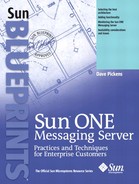Chapter 11. Migration
After you install the basic Messaging Server, one of the more difficult tasks is to migrate the existing user base and mailbox contents. Different techniques can be used, but only specific techniques are valid for specific migrations, Exchange for example. Additionally, other parts of the migration have specific issues, such as using the migration as an opportunity to standardize mail address formats while maintaining legacy addresses that can be addressed. This chapter describes the best practices for migration and identifies potential problems that may occur during the migration phase. The items that must be migrated are:
This chapter covers the following topics:
Basic Steps (Generic)
Sendmail (UNIX Mail)
Exchange, Novell Groupwise, and Lotus Notes
The process of installing a new messaging system can be divided into three phases:
Installation
Provisioning and maintenance of users
Migration from the old system
Previous chapters covered the basic installation of the Messaging Server and the maintenance and provisioning of users. This chapter covers the final stage—getting users off the old system and onto the new system.
Few, if any, organizations will be starting a brand new deployment of messaging. Migration of an existing email system is not trivial. Migration often consumes half of the overall project effort, but you can minimize the time you spend by planning and using the knowledge this chapter provides.
Decisions regarding whether to migrate everything at once or user by user (self service) must be made. Each method has its pros and cons.
